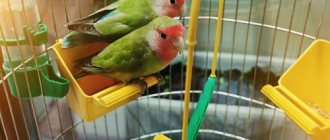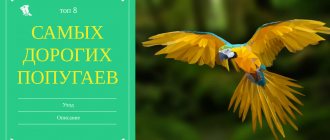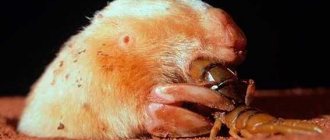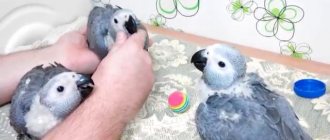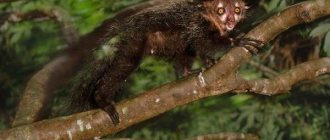There are a huge number of representatives of parrots. This order includes more than 330 species of very beautiful, bright, colorful birds. There are two families: cockatoos and parrots. The latter includes 5 subfamilies: true parrots, owl parrots, loris, woodpecker parrots, nestors. Parrots vary in size from species to species. Their body length ranges from 9.5 cm to 1 m. Bright colors predominate in the plumage. The beak is powerful and strong. With its help, the parrot not only obtains food, but also moves along the branches. Their diet includes mainly plant foods, nectar, pollen, and sometimes insects and larvae.
Genus Lovebirds
Masked lovebird
Rosy-cheeked lovebird
Black-cheeked lovebird
Who is more talkative: male or female?
It is generally accepted that males are more talkative, unlike females. But it is not always the case. Everything depends on the bird itself and its character, as well as on external factors: environment, living conditions, stress, and so on.
Both males and females can talk. The main thing is that the bird lives in comfortable conditions, it feels comfortable and constantly hears human speech. True, female budgies are really not very talkative.
Next
All types of Monk Parrot (Kalita, Quaker)
Rosella family
Red rosella
Tasmanian rosella
Common rosella
Pale-headed rosella
Corella
A small cute bird is called a cockatiel in Australia, and a nymph in Europe. The natural gray color of the parrot perfectly camouflages it in natural conditions. The nymph is a common type of parrot for home breeding, along with budgerigars. A cockatiel can live next to people for 18–20 years if you surround it with care and communicate with friends every day. This talkative bird, when alone, can get sick and become depressed.
The size of the parrot is average: the length of the body including the tail is 33 – 35 cm. Breeders have developed several color variations:
- lutino;
- cinnamon;
- albino;
- motley;
- pearl and others.
A common feature of any mutation of the gray parrot breed is orange cheeks, as well as a funny forelock on the head, similar to the distinctive attribute of a cockatoo. The cute crest gives the friendly bird originality and charisma.
It cannot be said that the nymph has an outstanding talent for learning, but she can speak after hard practice. In addition, the crested bird loves to sing and imitate the sounds of the surrounding world: it imitates the barking of a dog, the noise of household appliances, and car alarms. Despite her pleasant appearance, the cockatiel is quite loud, her voice is harsh, you need to get used to it.
Genus Ringed parrot
Himalayan ringed parrot
Plum-headed Ring-necked Parrot
Chinese ringed parrot
Rose-breasted Parakeet
Alexandrian ring-necked parrot
Indian ring-necked parrot
Cockatoo
It is known that the name of this species of parrot is associated with its powerful beak - in Malay “kakatua” means “biters”. The structure of the beak allows it to crack the hardest nuts, chew through thick branches, bite through cage bars, and even open locks. Another noticeable feature of the bird is the high crest of pink or yellow feathers on the crown. The cockatoo is considered a large species: its body with tail reaches a length of 70 cm. The wingspan of the average individual is 80 cm. They live in captivity for more than 40 years under favorable circumstances.
The family is divided into several species: yellow-crested, Inca, Moluccan, pink, black and others. The most luxurious breed is the Solomon white parrot. He has a spectacular appearance with a predominance of snow-white feathers, and a large crest of the same shade on his head.
Cockatoos are perfectly adapted to wild living conditions: they fly well, deftly climb trees and move quickly on the ground. The domestic parrot has nowhere to use these skills, so he has fun in any available way:
- with the help of a curved beak, he breaks open the locking mechanism of the door, pushes back the bolt and gets out of the cage;
- chases small domestic animals, treats them unceremoniously and mimics them;
- destroys furniture, chews wires, tears books and flowers;
- dances to the music and makes others laugh, enjoying their reactions.
The cockatoo is vindictive and aggressive, and can bite hard if it feels threatened. To channel the parrot’s unbridled energy into a peaceful direction, you need to transfer its attention to various puzzles and overcoming obstacles. Training and learning onomatopoeia is very interesting for cockatoos, as these birds are very intelligent and resourceful.
Genus Amazon parrots
White-fronted Amazon
Jamaican Amazon
Cuban Amazon
Holiday Amazon
Yellow-fronted Amazon
Blue-fronted Amazon
Macaw
A fabulously beautiful bird native to South America. The spectacular multi-colored parrot seems to be painted with bright watercolors of all shades of the rainbow. Birds of this species grow up to a meter in length and live 30–90 years. They learn well and can perform complex tricks, they speak in phrases and according to the situation, their brain is very well developed. The voice is shrill and unpleasant. Keeping such a majestic bird at home is inconvenient and inhumane, so macaws are mainly found in circuses, zoos, and nature reserves.
The difference in plumage color gives grounds to divide these parrots into four groups:
- the genus of macaws, in which there are 13 species;
- blue-fronted fellow;
- hyacinth, the largest and most expensive parrot on the planet;
- blue is a rare species, endangered.
The macaw is friendly towards humans and expects constant communication and care, like a small child. The remarkable abilities and colorful plumage of multi-colored parrots make people commit crimes. Poachers catch bright macaws for profit, aborigines - for food, and also to use feathers as decoration.
Rod Aratingi
Golden aratinga
Nandaya
Golden-capped aratinga
Aratinga-yandaya
Jaco
Perhaps the most intelligent parrot, easy to train and capable of learning several hundred words. The Gray's modest gray coloring is more than compensated by his phenomenal talent for onomatopoeia. The ash plumage of the body is diluted with a red or brown tail, a whitish mask on the head, and a black and very impressive beak.
Jaco is a long-liver; there are cases when the bird’s age was 50 years. On average, a tame parrot of this species lives 35–40 years; in nature, this period is much shorter due to many dangers. If you intend to get yourself such a pet, get ready for the difficulties of keeping a large bird. Not only is the cost of Grays in poultry markets and nurseries simply off the charts, but home improvement and high-quality feed will not be cheap.
For a smart bird, a person must become a friend; now not a single activity can be done without the participation of a bird. Maintaining your Gray's positive mood will be successful if you provide him with new toys, teach him tricks, and offer him various tasks. A parrot, left to its own devices, will begin to damage and destroy furniture and scatter garbage. A bored bird from idleness will begin to pluck itself, which will lead to serious illness.
Reproduction and offspring
Healthy and strong offspring are formed from pairs of birds belonging to different families. At the same time, the age at which parrots are ready to reproduce, for most species, occurs only at one and a half or two years, and the maximum productivity indicators are observed in three-year-old birds. Parrots are not characterized by too violent behavior during the mating season.
Parrots nest mainly in hollows, but they may well use burrows or termite mounds for this purpose. Birds are in most cases monogamous. In representatives of small species that live in large flocks, formed pairs sometimes break up under the influence of some unfavorable factors, including the death of a partner, unsuccessful nesting, or a disproportionate ratio between the sexes.
The largest species breed once a year, while smaller species may have two to four clutches per season. The clutch of birds varies in size and can consist of 1-12 (most often 2-5) eggs. As a rule, only females incubate eggs. The chicks are born blind and naked, and the parents feed their offspring by belching from their crops.
Return to content
Monk (Kalita) – European pigeon
This fairly popular variety of pets in Spanish, Brazilian and other cities is considered a street pet and is comparable to Russian pigeons. These birds began to be called monks because of the similarity of the colors of their plumage with the cassock. The crown, back and tail are bright green or turquoise, and the front of the face and body are pale brown.
But the character of these talking birds is not at all monastic. They are characterized by:
- playfulness;
- curiosity;
- impudence.
These parrots are easy to tame. They are not particularly talkative. Vocabulary – several dozen words. The voice is hoarse, as they say, not for everybody.
Range, habitat
Birds with variegated colors live in the subtropics and tropics. More than half of all currently known species live in Australia, and a third of the habitat of such birds is in South and Central America. A small part of parrots inhabits Africa and the countries of South Asia. Most often, parrots prefer forests, but some species can settle in steppe zones and mountainous areas. The birds' homes are abandoned termite mounds, holes and hollows.
Return to content
Whom to choose
If you plan to purchase a small parrot, then you can choose different breeds, focusing on your own preferences.
But at the same time, the recommendations of experienced breeders are taken into account:
- if there is a desire to teach a wavy to speak, then it is advisable to buy a wavy, and it should be kept alone, not in pairs;
- if a person wants the house to never be quiet, then it is important to choose a couple of lovebirds who chirp or sing a lot, and it is also always pleasant to observe the unusual habits of these birds;
- if a person wants a pet to be calm and pleasant in communication, then he buys a passerine parrot, which not only imitates human speech, but also screams a little.
When choosing, the cost of the parrot is additionally taken into account, since the price for different breeds varies significantly.
Kakapo
An unusual and rare parrot from New Zealand, the kakapo species, has a head structure that resembles an owl, hence its second name - owl. This is a very interesting, even unique species of parrot: it does not fly due to weak wings, it is nocturnal, females are half the size of males. The kakapo's voice resembles both the croak of an owl and the grunting of a pig.
The inability to fly does not mean that this parrot cannot climb trees: its heavy beak and dexterous wide paws with claws help it get food and escape from predators. They descend from a tree in a jump, balancing with the help of their wings. To minimize threats, the kakapo stays in its burrow during the day and goes out at night to search for food. In the dark, he is well oriented by smell; vision is not so important to him.
The color of the feathers was created by nature for better camouflage: dark green with brown and black specks.
Now this species is disappearing, kakapo parrots are under protection, so zoos cannot boast of the presence of a rare individual. The living conditions in the apartment are completely unsuitable for such an exotic bird. Birds do not reproduce in captivity, so the chicks are bred on farms, raised and released on the islands. Scientists are trying to increase the population without allowing the species to go extinct.
Population and species status
Parrots, as representatives of the species, have existed since the fifth century BC. For several millennia, the bird was exterminated because of its bright and beautiful plumage, and was caught for keeping in captivity. Active deforestation has also contributed to the decline in the number of such birds. Some species have already disappeared completely or are on the verge of extinction. Currently, the following are listed in the Red Book (IRC):
- Australian native parrot;
- Seychelles island parrot;
- some subspecies of Amazon parrots;
- grass common parrot;
- kakapo (night or owl parrot).
Kakapo is considered to be extinct in its natural habitat, so representatives of the species are kept today only in private nurseries and reserves. In addition to those listed, rare species include the Inca cockatoo, blue macaw, golden aratinga, royal amazon, as well as the Cuban macaw and Solomon cockatoo.
The conservation of rare species is carried out at the state and international level. For this purpose, the number of wildlife sanctuaries and reserves is increasing, and birds are being bred in captivity with the subsequent release of birds into their natural habitat. The fight against poaching and the ban on the illegal export of rare birds from the country are also considered effective.
Return to content
Structural features
Parrots are inhabitants of the tropics and subtropics, so most of the species are found in South America and Australia. Moreover, half of the known parrots live on the Green Continent, in particular budgerigars and cockatiels. They feel most comfortable in forests, but are distributed everywhere: plains and meadows, mountains, floodplains.
At the moment, scientists count 87 species in the world, but the inaccessibility of some regions of tropical latitudes suggests that the list is far from complete.
Despite the huge diversity in size, wingspan, colors and habitats, they are all united by curiosity, an open interest in humans and a desire to learn. It was they who initiated the alliance with Homo Sapiens.
The largest breeds of parrots cannot be called ideal “flyers”. The larger the parrot, the less time it spends flying in natural conditions.
The cockatoo, for example, prefers to glide and jump from branch to branch, moving along a tree trunk like its ancient ancestor, Archeopteryx (the “grandfather” of all modern bird species).
Body length ranges from 9 cm to 1 meter. Most typical representatives of the order are brightly colored: the dominant colors are yellow and green. Their characteristic feature is an impressive beak, which is similar in structure to the beak of birds of prey; it is needed for movement and feeding.
In addition to the fact that these birds can peck hard fruits with their beak, they also use it when climbing trees, deftly clinging to branches. In addition, the beak is a source of pride for males; with its help they sort things out in ritual fights (non-aggressive and more reminiscent of a dance). “Savages” most often lead a nomadic lifestyle, moving from a feeding place to a new sleeping place.
Kea
Another peculiar parrot that lives in New Zealand is the kea or nestor. The main habitat is beech forests and bushes in the mountainous areas of the South Island. The Nestor is similar in size and appearance to a crow. Sometimes an individual grows up to half a meter in length and gains a mass of more than a kilogram. Feathers the color of ripe olives cover the top of the body, and in flight the bright shades of the inner side of the wings are revealed.
Why is this species interesting? Kea are famous for their sharp mind and mischievous nature, they play pranks on the verge of crime:
- approach tourist centers and damage property;
- steal food, accessories and equipment;
- dump trash containers.
The curiosity of parrots knows no bounds; for entertainment, they even gather in groups and lie in wait for people, begging for treats. In bad weather, when the wind blows, kea love to demonstrate the wonders of acrobatics, again for this they need spectators.
The unpleasant activity of these brown pests previously included the fact that they attacked sick and lost sheep. An animal that strayed from the herd was subjected to a brutal attack by birds of prey, which sat on its back and pecked the subcutaneous fat. In a fit of vengeance, farmers began to exterminate the vandal birds, which almost led to the extinction of the species. Now ornithologists are intensively restoring the number of kea, these parrots are protected by law.
Natural enemies
Natural enemies of parrots are represented by large feathered predators, as well as many terrestrial predatory animals. The meat of some species of parrots, especially cockatoos and Amazons, is actively used as food by the indigenous Indians inhabiting the territory of South America, as well as by Australian aborigines.
According to the testimony of travelers and scientists, some Indian tribes of the Amazon have long raised macaws. Birds raised in this way are not killed for meat, but are used exclusively for periodically plucking colorful, bright feathers necessary for making ceremonial headdresses.
Return to content


